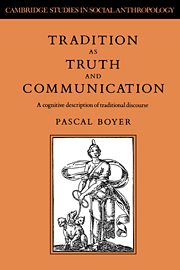Book contents
- Frontmatter
- Contents
- Preface
- Acknowledgements
- 1 Conserved world-views or salient memories?
- 2 How to think with ‘empty’ notions
- 3 Criteria of truth
- 4 Customised speech (I): truth without intentions
- 5 Customised speech (II): truth without meaning
- 6 Customised persons: initiation, competence and position
- 7 Conclusions and programme
- Notes
- Bibliography
- Index
- Cambridge Studies in Social Anthropology
1 - Conserved world-views or salient memories?
Published online by Cambridge University Press: 27 August 2009
- Frontmatter
- Contents
- Preface
- Acknowledgements
- 1 Conserved world-views or salient memories?
- 2 How to think with ‘empty’ notions
- 3 Criteria of truth
- 4 Customised speech (I): truth without intentions
- 5 Customised speech (II): truth without meaning
- 6 Customised persons: initiation, competence and position
- 7 Conclusions and programme
- Notes
- Bibliography
- Index
- Cambridge Studies in Social Anthropology
Summary
The ‘traditional’ cultural phenomena concerned here can be briefly characterised by the following features:
(i) they are instances of social interaction:
(ii) they are repeated;
(iii) they are psychologically salient.
Let me comment briefly on these abstract phrases, using a prototypical case of the sort of institutions I will talk about. After his first trance, a newly initiated shaman tells an audience of fellow-shamans and villagers of the contract he has made with the spirits of the jungle. I will call this event ‘traditional’. This usage of the term is not really contentious. It is important, however, to be clear about what sort of objects we are dealing with; otherwise some crucial (and typical) mistakes may creep in and make the discussion hopelessly confused.
First, what I mean by saying that I will deal with instances of social interaction is simply that we are concerned here with actual events, with the things people actually do and ethnographers observe, not the things anthropologists think should be posited in order to explain what people do. That is to say, the social phenomenon considered here, and labelled ‘traditional’ is the shaman's singing, more precisely the social event of the shaman's singing to a certain type of audience, about a certain type of mystical experience, etc. Now an anthropological account of this event should include many other things, notably a series of hypotheses about the organisation of people's ideas, the social organisation of the place, people's emotional involvement in the ritual, and so on.
- Type
- Chapter
- Information
- Tradition as Truth and CommunicationA Cognitive Description of Traditional Discourse, pp. 1 - 23Publisher: Cambridge University PressPrint publication year: 1990



